How to Earn Passive Income with DeFi - Beginner's Guide
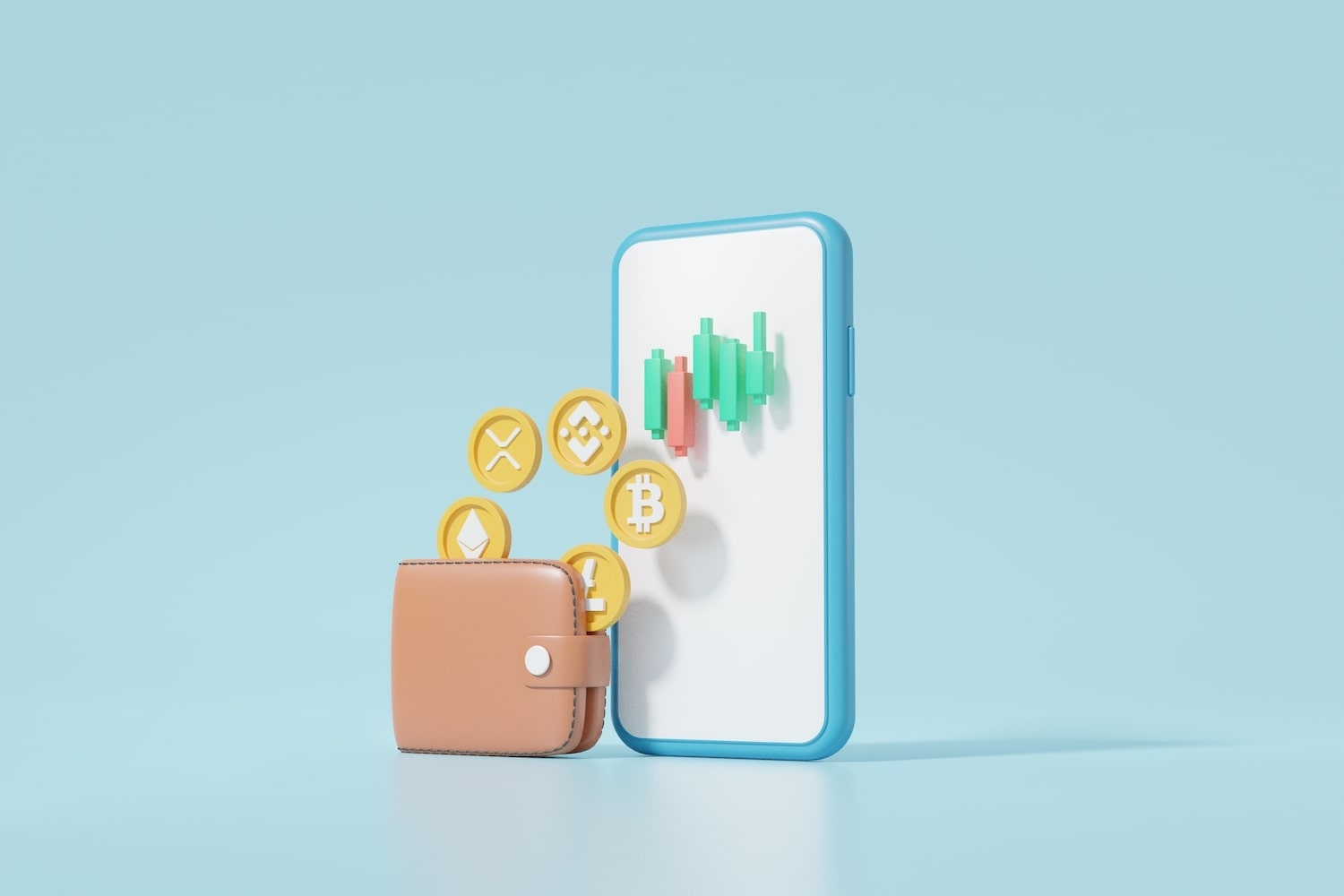
This article will explain how to earn passive income with DeFi.
You can learn the followings:
- How to earn passive income with DeFi
- How do I conduct a DeFi risk assessment
- Which projects are safe to invest money
- How are DeFi yields so High? The secret
- Easy to understand for Crypto beginners
You can understand the above through this article.
For reference, I'm an experienced investor in DeFi. I've been investing in this field since 2020, and the amount of money I invest in is more than $3 million. Current APY is about 10% year which is not so high, but I'm satisfied.
Table of contents
- 1. How to earn passive income with DeFi
- 2. How do I conduct a DeFi risk assessment
- 3. My DeFi Portfolio ( Low-Risk / APR10% )
1. How to earn passive income with DeFi
There are three ways to earn passive income:
- (1) Staking
- (2) Lending
- (3) Yield Farming ( ≒ Liquidity Mining )
(1) Staking
If you have Crypto (eg: ETH, SOL, LUNA, MATIC), you can stake and earn passive income like below:
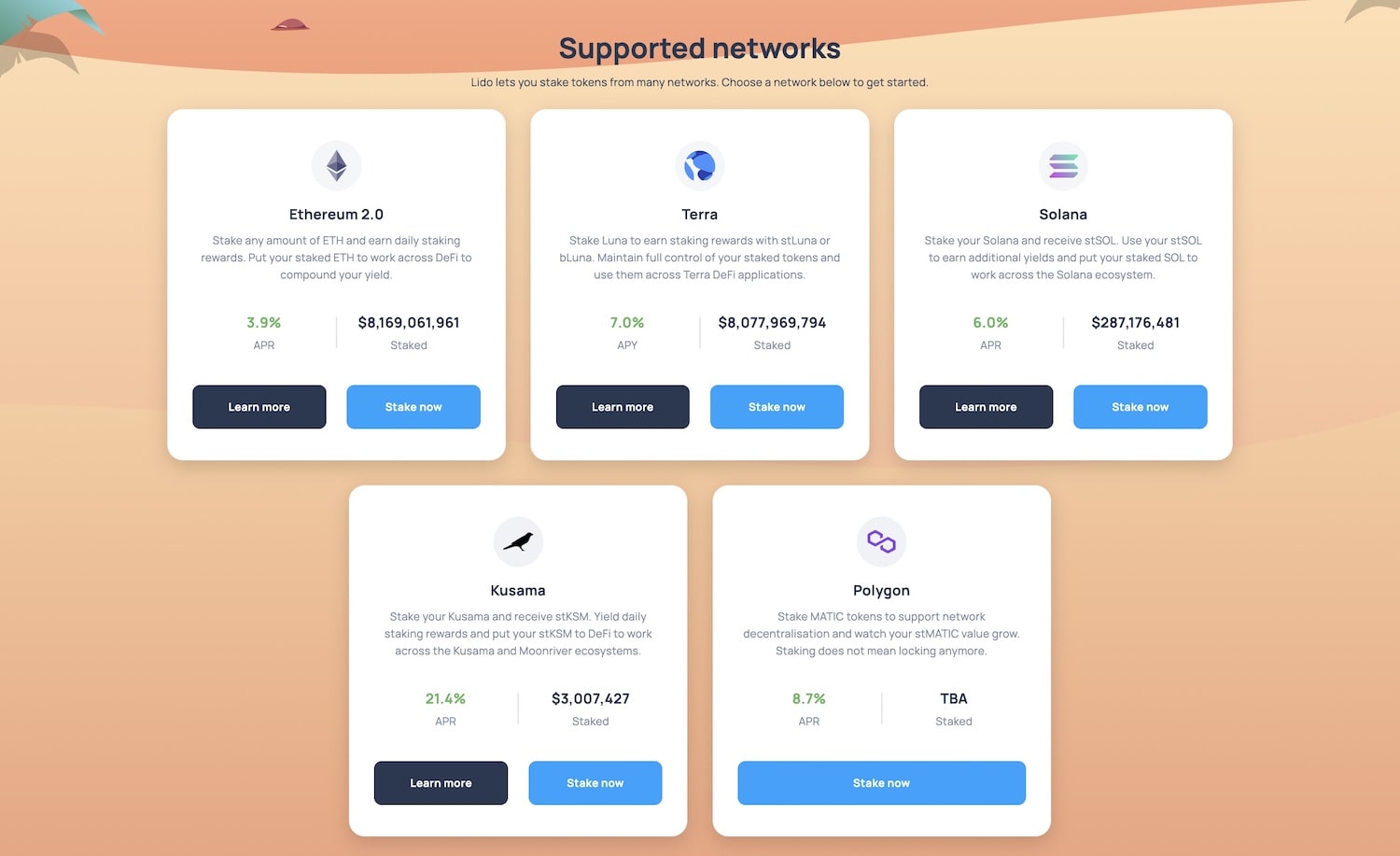
The above is the screenshot of Lido, which is a liquid staking solution. Lido lets users stake their Crypto without locking assets.
For example, if you want to stake your ETH and earn passive income, you need to accept two conditions below:
- Minimam deposit: 32ETH ( = $95,512)
- Lock-up period: Until ETH2 release
A minimum deposit of 32 ETH is a large amount of money. Also, the Lock-up period is one that many people don't like. To make matters worse, the release date of ETH2 has not been confirmed yet.
Using Lido, you can avoid these conditions. If you stake ETH on Lido, you can get stETH, which is the deposit certificate of your ETH. You can exchange your stETH anytime using DeFi exchange such as Curve or SushiSwap.
Related Projects
Rocket Pool is also famous in this field. For example, you can stake ETH using Rocket Pool and earn passive income. Another example is Binance staking, which you can see below:

Also, you can use Coinbase as a staking service. Needless to say, there are many more. You can Google it with "crypto staking services."
*To be exact, Binance and Coinbase are not DeFi but a central exchange. I introduced it because I thought it was helpful information.
(2) Lending
The famous lending services are as follow:
There are many lending services in DeFi, but these two projects are the biggest. It's easy to use lending apps like below:
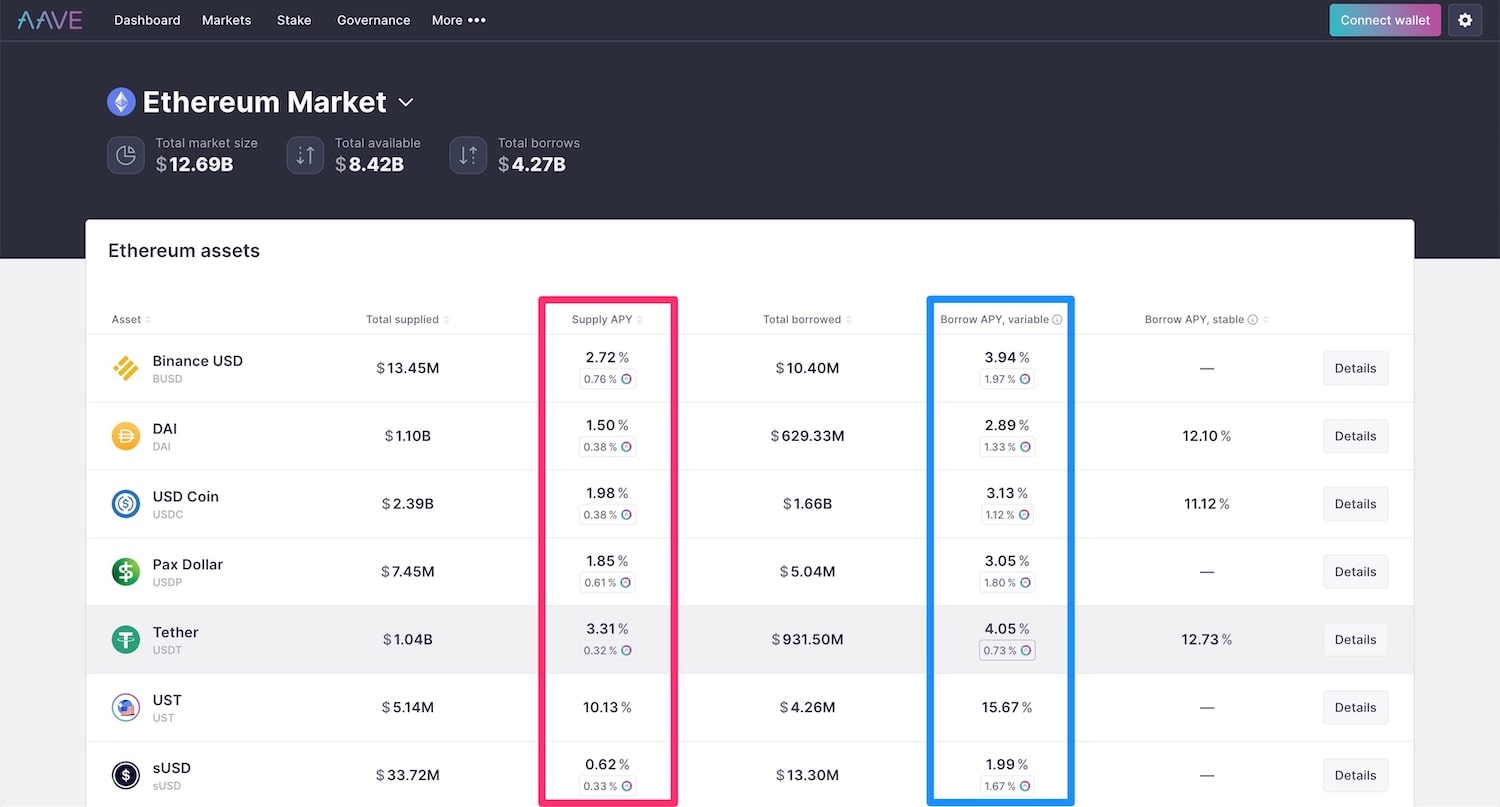
You can see Supply APY (Red box) and Borrow APY (Blue box). For example, if you supply USDC on Aave, you will get 2.36% APY (1.98% APY with USDC + 0.38% APY with Aave coin). *USDC is a digital currency fully backed by U.S. dollar assets.
It's better than a bank deposit, right? But you may think the APY is not so high as you expected.
I use Aave to borrow USDC
In my case, I use Aave like so; this is the screenshot of my portfolio:
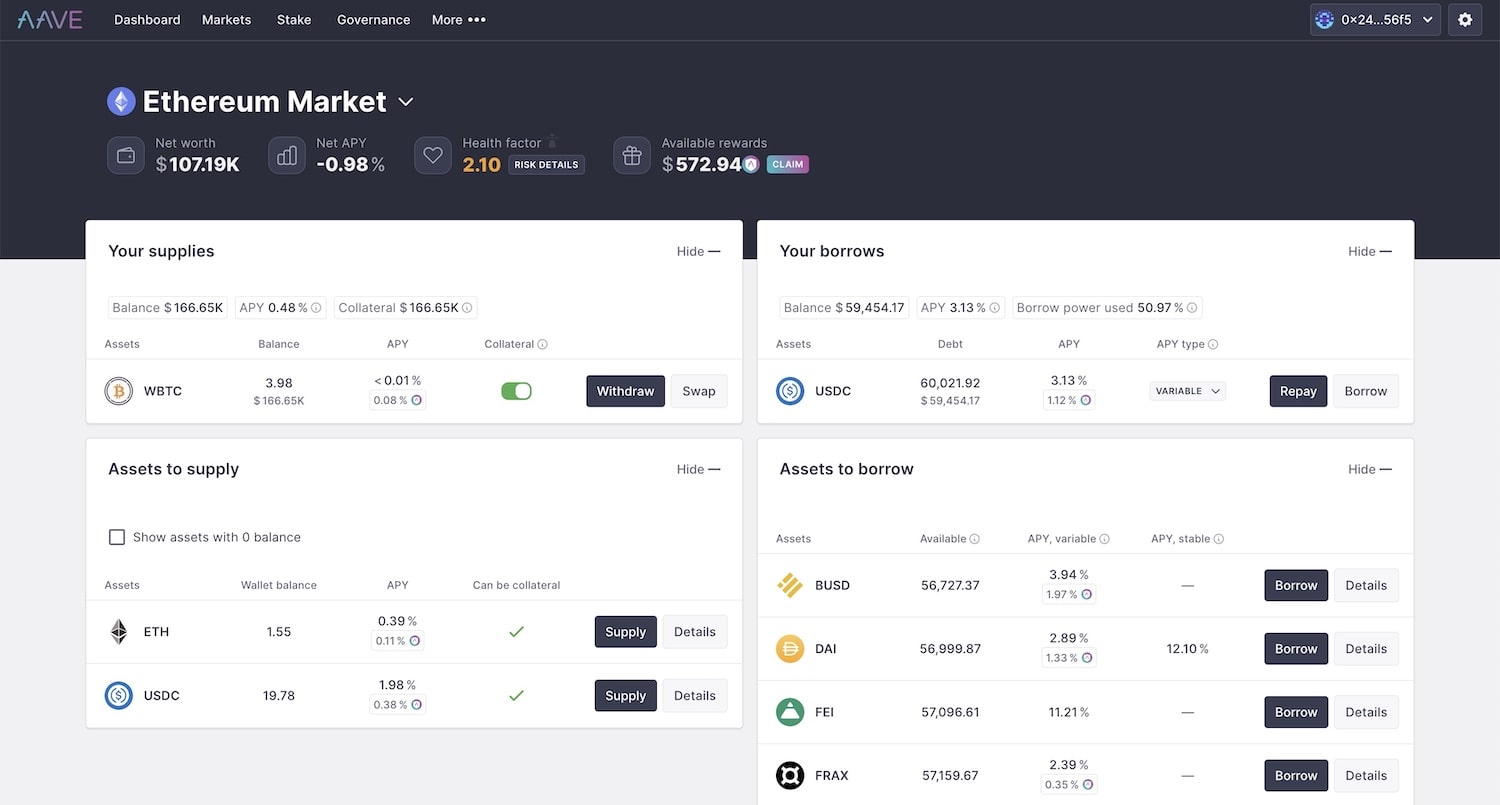
You can see that I'm supplying BTC and borrowing USDC. But most people think why I'm borrowing USDC. The answer is to earn passive income using Yield Farming ( ≒ Liquidity Mining ). So let me explain in the next paragraph.
*For reference, you can use BlockFi, a lending service. It's not DeFi but a central exchange and Investment app. You can earn around 8% APY supplying USDC. It seems higher than Aave, but you can achieve higher APY using Yield Farming, which will explain next.
(3) Yield Farming ( ≒ Liquidity Mining )
Yield Farming ( ≒ Liquidity Mining ) is an innovation of DeFi.
Yield farming is a process that allows cryptocurrency holders to earn rewards on their holdings. With yield farming, an investor deposits units of a cryptocurrency into a lending protocol to earn interest from trading fees. Some users are also rewarded with additional yields from the protocol’s token.
For example, take a look at the screenshot below:
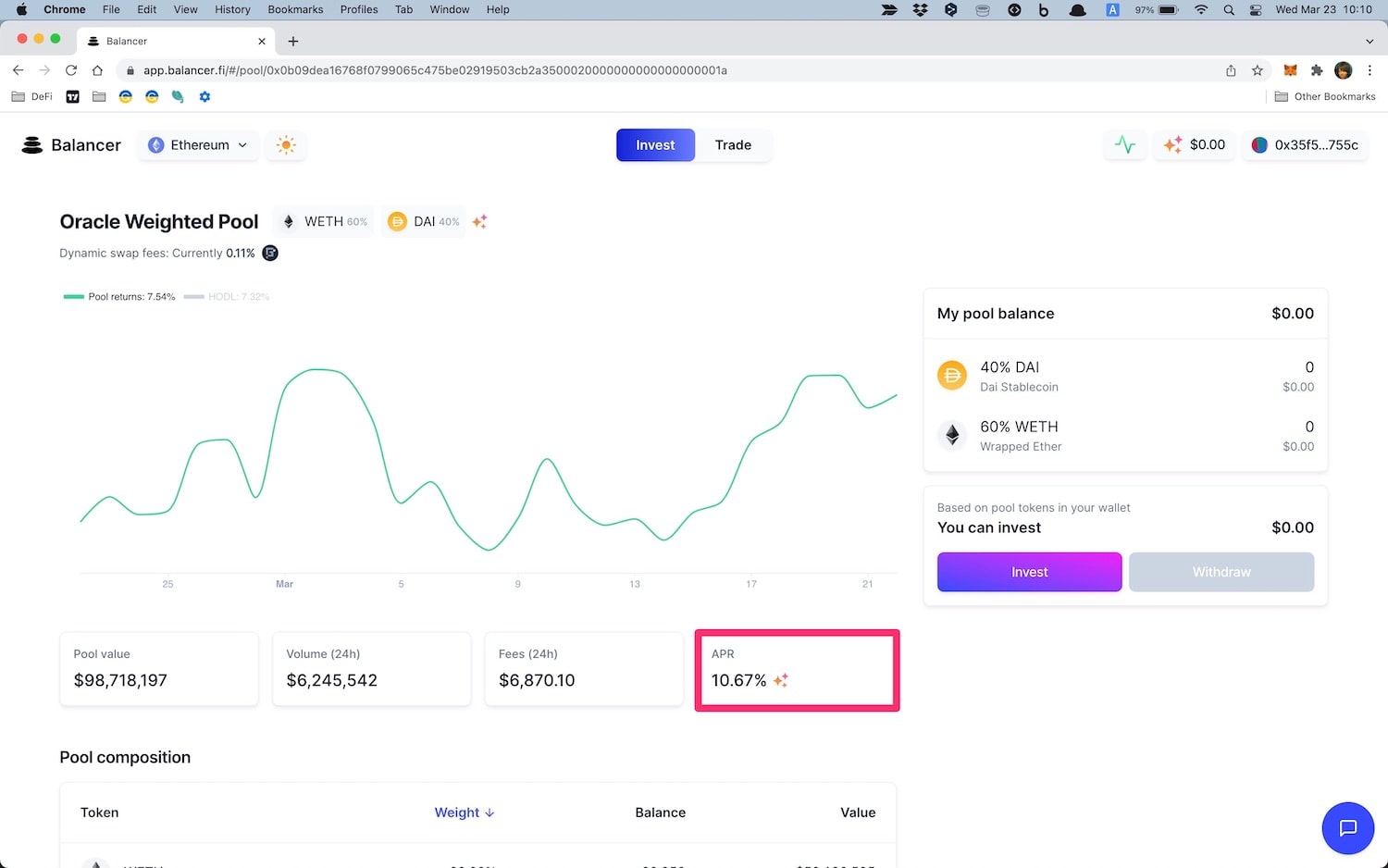
It's a screenshot of Balancer. You can see the 10.67% APR (Red box), which means if you supply ETH and DAI( = stable coin pegged to the USD), you can earn 10.67% APR.
That's why I'm borrowing USDC on Aave. Using Aave, I can deposit my BTC or ETH to earn interest from trading fees without selling them. I'm bullish on BTC and ETH, so Aave is useful for me.
Deep dive of Balancer’s APR
In more detail of Balancer, you can see the popups below when you mouse hover on the APR box.
Total APR: 10.67%
∟ Swap fees APR: 1.27%
∟ Liquidity Mining APR: 9.40%
The meaning of the above is following:
- Swap fees APR: You can earn interest from trading fees. Every time Balancer user swaps their token. You can get a small percentage of the trading fee.
- Liquidity Mining APR: It's a kind of bonus APR. Balancer gives you an additional token to attract more customers.
There are so many DeFi projects, but you can easily find the famous one using DefiLlama, a blockchain analytics platform:
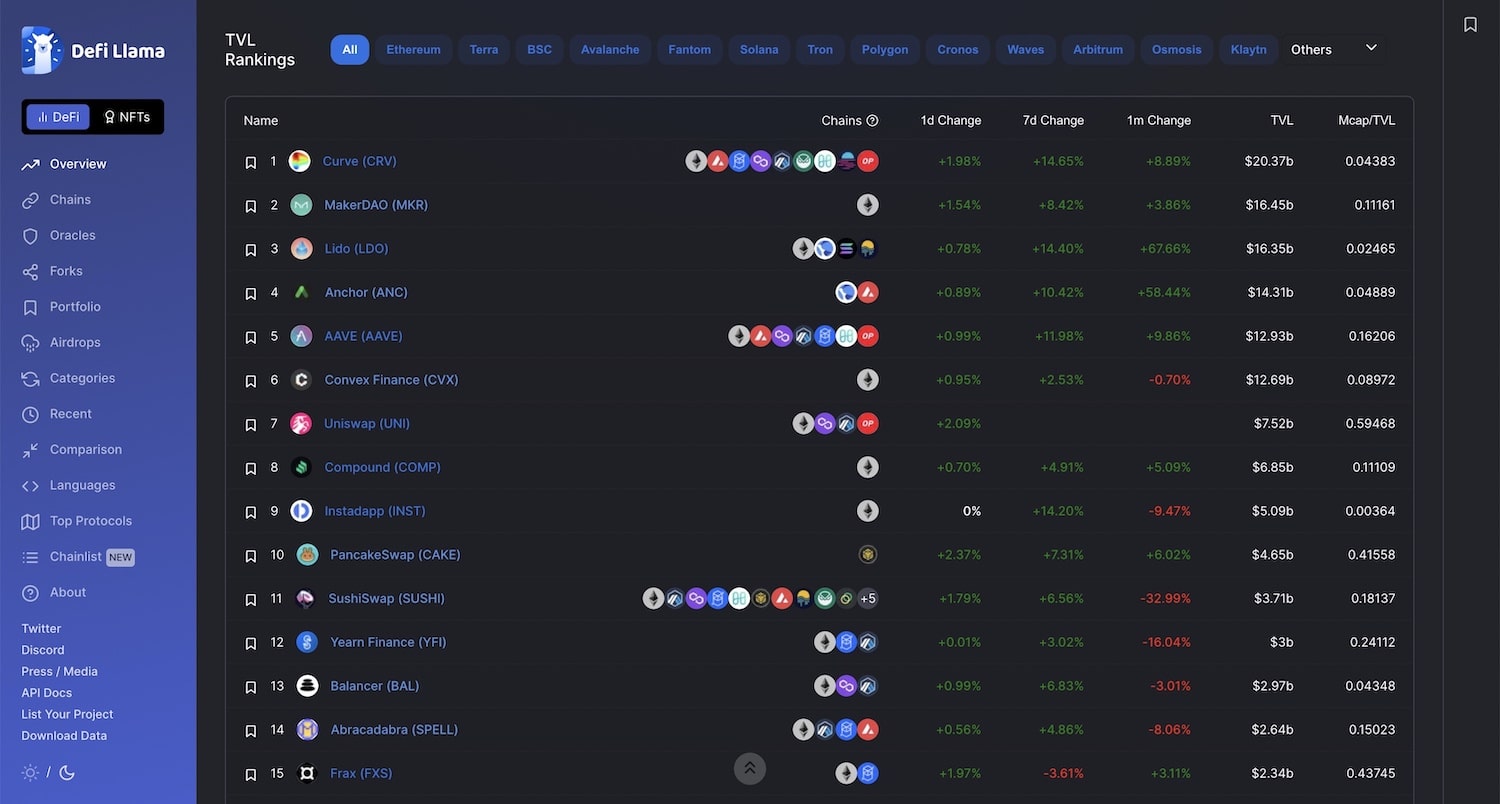
I'm using Curve, Aave, Convex, and Uniswap. Those projects generate a yield of roughly about 10% a year.
Important note: You can get a higher yield using not famous DeFi apps, but it will increase the risk. Next, let me explain how to conduct a DeFi risk assessment.
2. How do I conduct a DeFi risk assessment

There are five things you should concern about:
- (1) Chain
- (2) Layer
- (3) Bridge
- (4) Payout
- (5) Malfunction
(1) Chain
There are so many blockchains in this field:
- Ethereum
- BSC Chain
- Avalanche
- Solana
- Polygon
Basically, the more famous blockchain you choose, the more safety you get.
In my case, 80% of my assets are in Ethereum chain because it's safe and stable. If I chose Solana chain as my main chain, the APY I will get much higher. But needless to say, it will increase the risk.
(2) Layer
It's crucial to understand the layer of DeFi.

You can see the pyramid above, which means the more you use the base layer, the more safety will increase because DeFi has composability:
Composability, in DeFi, is the ability for applications and protocols to interact with one another in a permissionless way — meaning they are constantly talking to one another and leveraging each other’s code.
For example, you can see MAKER project on top of Ethereum, which means MAKER inherits the risk of Ethereum. If Ethereum has been compromised, MAKER will also get the same situation.
*Maker is a decentralized credit platform on Ethereum that supports Dai, a stable coin whose value is pegged to USD.
In more detail, you can see Curve, SushiSwap, and Uniswap on top of the pyramid, which means these projects inherit the risk of the lower layer's projects.
(3) Bridge
We can see so many projects related to bridges. For example, using DeFi bridge, you can transfer tokens from one chain to another. But please take a look at below:

The bridge you can see above connects Ethereum to other chains. And you can see the money is stacking in the middle of the bridge.
For these reasons, hackers target a bridge these days. So if you want to use Bridge, it's better to research before putting in your money.
*For reference, I wrote an article about Risks and Importances of Ethereum bridge. Please read it if you're interested.
(4) Payout
Payout is also very important. For example, if you use Curve, your APR will be paid by CRV, which is the token issued by Curve.

Please take a look at the above. Here is the explanation:
- Base APY: Payout with pool token. Eg: if you use ETH pool, your payout will be ETH.
- Rewords APY: Payout with CRV token, issued by Curve. Fluctuating so much.
If I put some money into the pool with a higher than 30% APY, and then the payout token price decreases, which is no meaning. The APY is true, but the actual $ gain is much lower than expected.
Tips: How to create a 100% APY
If I create Hoge-Hoge-Swap and then set a 100% APY is easy. Because I have made a Hoge-Hoge-Swap, and I have so many Hoge-Hoge-Token. I disperse so many Hoge-Hoge-Token and then set 100% APY to attract new customers. This is happening in real life. So be careful of the payout token.
(5) Malfunction
There are many APY calculator tools, but be careful of them. For example, is below:

The above is Uniswap APY Calculator by Metacrypt. You can see 85% APY with USDC-ETH pair, but is it true? I don't think so. Another example is below:

The above is Uniswap APY Calculator by Flipside. You can see 30% APY with USDC-ETH pair.
Actually, I'm using Uniswap's pool, and the current APY is roughly about 10%. So, I think the tool by Metacrypt and Flipside are wrong. The tools are useful, but creating a spreadsheet and then checking your APY by yourself is much better.
3. My DeFi Portfolio ( Low-Risk / APR10% )

Lastly, I will share my portfolio with you.
- Uniswap: ETH-USDC, BTC-USDC, ETH-BTC
- Aave: Supplying BTC, Borrowing USDC
- Curve: USDT-BTC-ETH (Using Arbitrum)
- Convex: USDT-BTC-ETH (Using Curve)
- Binance: Staking BNB using Binance earn
Uniswap: ETH-USDC, BTC-USDC, ETH-BTC
Uniswap is one of the largest decentralized exchanges (or DEX) operating on the Ethereum blockchain. I'm using the pools like so:
- ETH-USDC:10% APY
- BTC-USDC:10% APY
- BTC-ETH:7% APY
That's 80% of my portfolio, which will earn the yields about 5 figures every month. I'm not securing my profit. I'm bullish on BTC and ETH.
Aave: Supplying BTC, Borrowing USDC
Aave is one of the most famous lending projects. I supply BTC and borrow USDC so that I can use BTC-USDC pool without selling my BTC.

I have to pay about 3.13% APY to borrow USDC, but there is no problem. Because I can earn more than that borrowing APY.
If you want, you can leverage trading your borrowings using Instadapp, a complete toolkit for DeFi applications. But needless to say, it will increase the risks of your portfolio. So I'm not using it. I like the safety portfolio.
Recommended Tool:
I use Aave liquidation calculator. For example, you can see my wallet below:
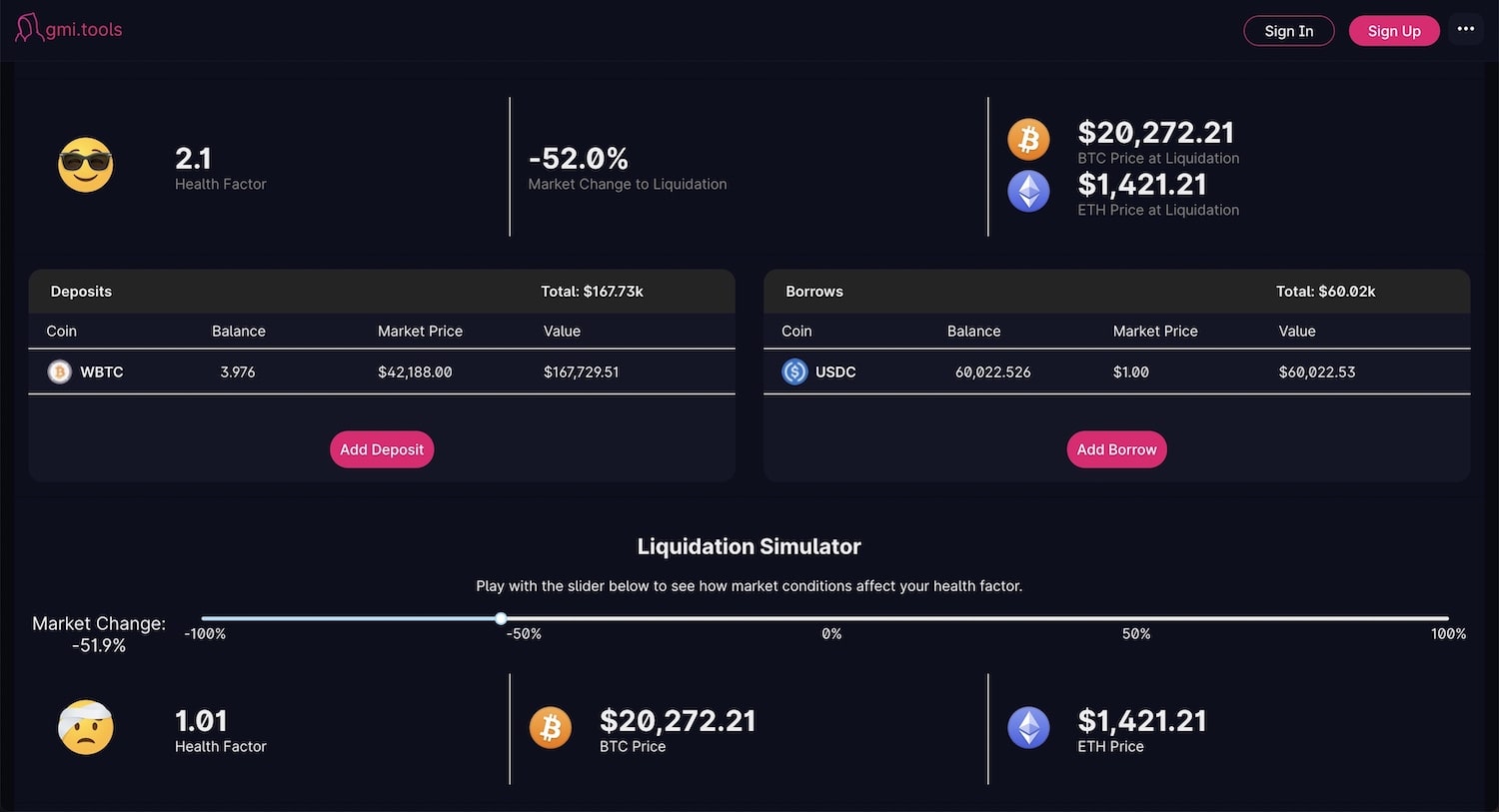
You can see the Liquidation Simulator, which is very useful. In my case, I will be liquidated if the BTC price drops by $20,272. So when you use Aave, be careful of the liquidation price of your position.
Curve: USDT-BTC-ETH (Using Arbitrum)
Curve is a decentralized exchange (or DEX) running on Ethereum. It's designed especially for swapping between stable coins.
I use Curve on Arbitrum, one of the most popular Ethereum scaling solutions. The pool I'm using is USDT-BTC-ETH (APY: 11%).
I use Arbitrum to expect a future airdrop; participants are given free crypto coins or tokens by a new service.
Recently airdrop: $130,000 from BAYC
I have a BAYC NFT, so I got an airdrop from the foundation of BAYC.

So,, you know the price of an airdrop? It was $130,000. So crazy. Also, I got an airdrop from Uniswap before; it was about $30,000. So, things I want to tell you is airdrop is tremendous. Too big to ignore.
The thing is, history will repeat itself. So I guess the next big airdrop is from Ethereum Layer2 (Eg: Arbitrum or Optimism). So that's why I'm using Curve on Arbitrum.
Convex: USDT-BTC-ETH (Using Curve)
Convex is a platform that boosts rewards for Curve's stakers and liquidity providers.
Convex is relatively high risk compared to the other projects I introduced. The reason can be explained using the images below:

You cannot see Convex in the image, but it will be located at the top of the pyramid. So, it means Convex will inherit the risk of the lower layer.
10% of my portfolio is in Convex, a massively growing project. Convex is growing because of Curve War, which you can learn from Is Convex the YFI killer.
Binance: Staking BNB using Binance earn
Lastly, I use Binance Earn for my BNB token.
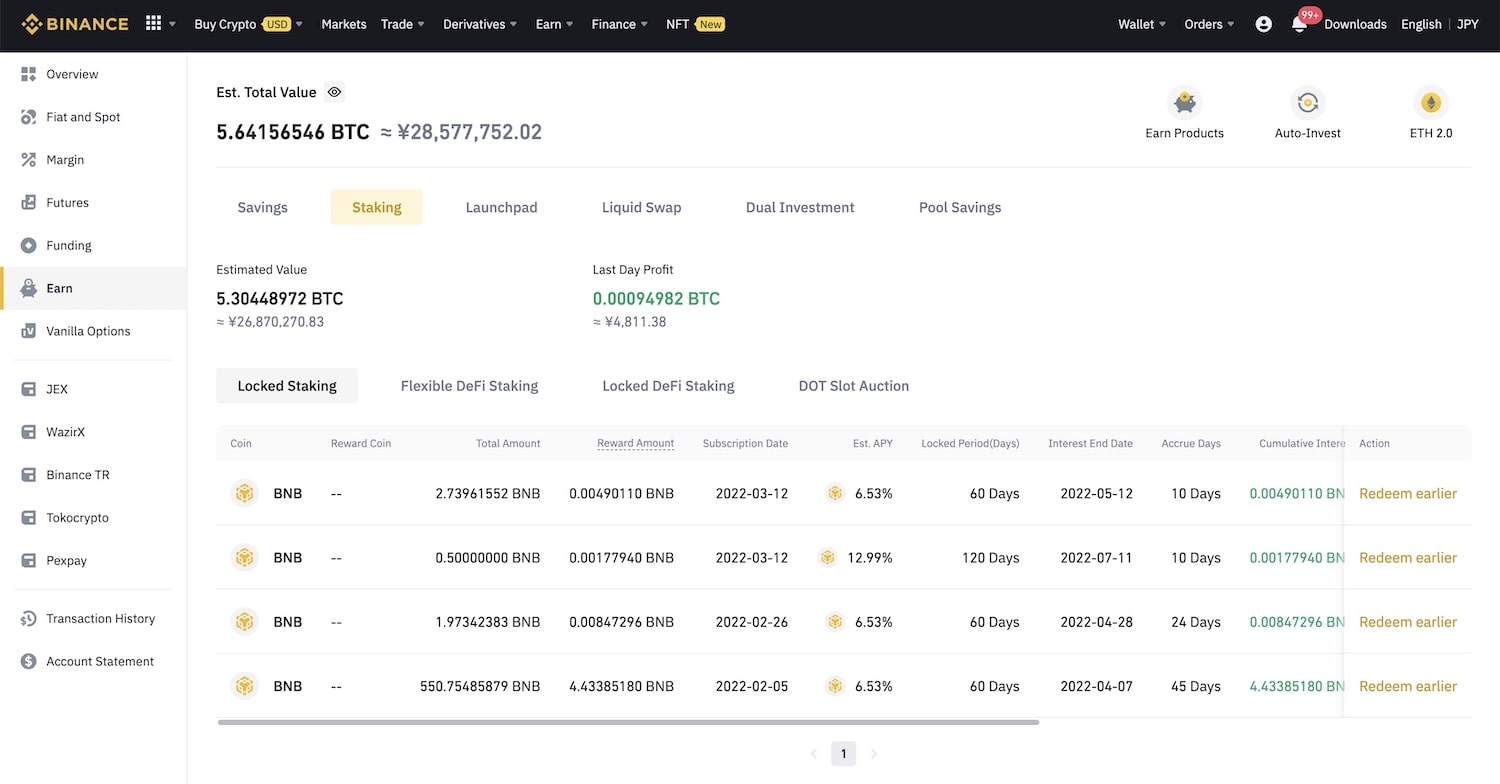
The above is my portfolio. Simply using locked-staking for 60~120 days.
I used Binance Smart Chain (DeFi) before, but the APY is going down, so I quit using it and then put my money into locked-staking. If the APY increases on Binance Smart Chain, then I will come back there.
That's it. Thanks for reading my article :)
